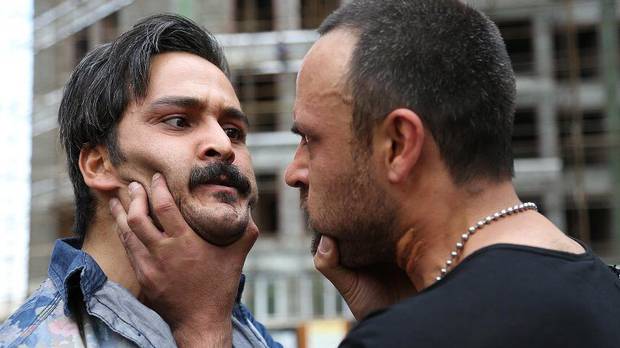The Toronto International Film Festival prides itself on cultural diversity, screening movies from 83 countries in its 2016 edition alone. But a single festival, even one the size of TIFF, cannot show every international gem – which may be why Toronto plays host to dozens of other festivals that cater to niche audiences and communities. Hot Docs, Inside Out, Planet in Focus, Cinéfranco, ImagineNative, Reel Asian – and those are just the first ones that pop to mind.
The CineIran Festival is one of the newest kids on the block. Screening 11 films over the course of three days this weekend at the TIFF Bell Lightbox, the Iran-focused fest was founded by Amir Ganjavie. Part of CineIran’s mandate is to expand Westerners’ perception of Iranian cinema.
“We think Iranian cinema as a national cinema is bigger than what most festivals portray it to be,” says artistic director Amir Soltani, though he admits that “it’s not [those festivals’] fault. There are so many countries, so many national cinemas – you can’t have seven or eight films from each country every year.”
Only one Iranian film, for example, was programmed at TIFF this year: The Salesman by Asghar Farhadi (best known for A Separation, which won best foreign-language film at the 2012 Academy Awards). Iranian cinema has been renowned since the 1990s for its poetical humanism and social realism thanks to directors such as Abbas Kiarostami, Jafar Panahi and the Makhmalbaf family, but in recent years its profile has been less pronounced, outside of Farhadi. Still, that doesn’t mean the country’s film culture is any less vibrant or varied.
“With Toronto’s huge Iranian community and Iranian cinema being particularly prolific in the past few years, we felt there was a lot of potential to find audiences for these films,” says Soltani, who notes the large contingent of Iranian-Canadians living in Richmond Hill and North York.
Soltani’s instincts were right: In its first edition, CineIran filled the majority of its seats – it sold about 3,400 tickets, or roughly 80 per cent of its capacity – even with programming avant-garde fare like 316, a 75-minute experimental film about shoes. “We can show films people wouldn’t normally trek to a venue for,” Soltani says. “As part of a festival, it can find an audience.”
Currently, CineIran audiences consist mostly of the immediate Iranian community, but Soltani and Ganjavie hope to attract more non-Iranians in the future. But that might take time. “It’s important not to be impatient because the first few years, it’s best to first target your own community until it takes off,” says Marcelle Lean, founder and organizer of Cinéfranco, which celebrates French-language film.
In Cinéfranco’s earlier years the audience was mostly francophone, but it now draws a higher number of anglophones, too. According to Lean, one of the best strategies to attract new audiences is to ask people of other communities to co-present a film. At this year’s upcoming Cinéfranco, for instance, Middle Eastern arts and culture magazine REORIENT will co-present All Three of Us, a French dramedy about an Iranian political prisoner.
Many festivals use such partnerships to increase outreach. Reel Asian is frequently contacted by festivals such as Inside Out or Images when it screens Asian films. “We’ll become a community partner, and help promote the film to our networks, with recognition in their books and on their website,” says Louanne Chan, executive director of Reel Asian. That sometimes involves going a bit further – say, not necessarily asking a Korean community member just because the film happens to be Korean. “It could be a cinephile group or a cinema-studies group at the University of Toronto,” adds Chan, “and that’s the way we try to explore expanding our audiences.”
For the Armenian-themed Pomegranate Film Festival, now in its 11th year, the power of celebrity can also help. “[Toronto filmmaker] Atom Egoyan and his wife [actress] Arsinée Khanjian are big supporters,” says Araz Hasserjian, of Pomegranate. In addition to Egoyan’s Remember, Pomegranate will screen the journalism drama Spotlight to highlight the contributions two Armenian-Americans (lawyer Mitchell Garabedian and reporter Stephen Kurkjian) made to the real-life case.
Representing a culture’s wider diversity of cinema is paramount for many of these festivals, which often includes the work of diaspora filmmakers. “Being a Canadian festival, we try to stress the importance of showing Asian-Canadian work,” says Reel Asian’s Chan. “Asian films at TIFF are more of the large, million-dollar-budget commercial fare. Not that we never show fare like that, but we support independent cinema. That’s what sets us apart.”
Soltani adds that variety is integral to demonstrate the breadth of a national cinema. “We don’t want a festival that’s all heavy-hitting dramas,” he says. One of his recommendations for this year’s CineIran is Rabidity, “a neo-noir film set in underground casinos.”
Soltani admits there is a steep learning curve to programming. Last year, his team tried to push more ticket sales by cutting prices in half, but received complaints from patrons who’d bought tickets at full price. “Anything you start, your first experiences are difficult but then you get into the groove and learn what to do,” Soltani says. “But generally speaking, the reception of the community has been enthusiastic.”
How much of this year’s support will come from non-Iranians is to be seen, but Soltani isn’t so much worried about that as he is about continuing to expand the festival via community connections and sponsorships. CineIran is a volunteer-driven event – a common occurrence for smaller film fests, but a nonetheless alarming one.
“Truly, blood, sweat, effort, energy and money is poured into this festival,” says Soltani. “So when you’re putting all of that into a venture, after 72 hours you’re drained of energy, and then someone runs into you on the street and says, ‘Great work’ – that’s heartwarming. You know it wasn’t all in vain.”
Originally published in The Globe and Mail (October 16, 2016).

